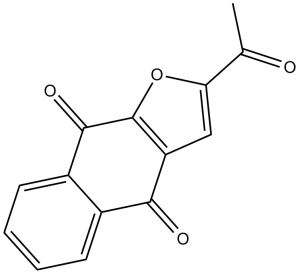Napabucasin (BBI-608)
This product is for research use only, not for human use. We do not sell to patients.

For small sizes, please check our retail website as below: www.invivochem.com
| Size | Price | Stock |
|---|---|---|
| 250mg | $650 | In Stock |
| 500mg | $1150 | In Stock |
| 1g | $1725 | In Stock |
Cat #: V1386 CAS #: 83280-65-3 Purity ≥ 98%
Description: Napabucasin (formerly also known as BBI-608; BBI608; BBI 608) is a novel, potent, and orally bioavailable cancer cell stemness inhibitor with potential antineoplastic activity.
References:
Top Publications Citing Invivochem Products
Publications Citing InvivoChem Products
Product Promise

- Physicochemical and Storage Information
- Protocol
- Related Biological Data
- Stock Solution Preparation
- Quality Control Documentation
| Molecular Weight (MW) | 240.21 |
|---|---|
| Molecular Formula | C14H8O4 |
| CAS No. | 83280-65-3 |
| Storage | -20℃ for 3 years in powder formr |
| -80℃ for 2 years in solvent | |
| Solubility In Vitro | DMSO: 10 mg/mL (41.6 mM)r |
| Water: <1 mg/mLr | |
| Ethanol: <1 mg/mL | |
| Solubility In Vivo | 5% DMSO+corn oil: 1 mg/mL |
| Protocol | In Vitro | Napabucasin inhibits the expressions of stemness markers and kill stemness-high cancer cells isolated from several kinds of tumors except PCa. Napabucasin not only inhibits cell proliferation, cell motility, cell survival, colony formation ability, and tumorigenic potential of PCa cells, and increases cell apoptosis and sensitivity to docetaxel, but also effectively blocks sphere formation of PrCSCs and kill them as well as inhibits stemness gene expression. Napabucasin inhibits cell proliferation in PC-3 cells and 22RV1 cells at 48, 72, 96, and 120 h (P<0.05). Cell motility and colony formation ability are closely correlated with the process of tumor metastasis. Napabucasin significantly decreases colony formation and cell motility ability of PCa cell lines in vitro (P<0.05). The proliferation of PC-3 and 22RV1 cells treated with 1 μM Napabucasin are significantly decreased from day 2 to 5 compared with the control group (P<0.05) |
|---|---|---|
| In Vivo | Napabucasin (40 mg/kg) or Docetaxel significantly reduces xenograft tumor growth and tumor volume (TV) compared with PBS (P<0.05). Notably, while no differences are observed between the Napabucasin and the docetaxel groups in PC-3 mouse xenograft models, the TV in Napabucasin group is even lower than docetaxel group in 22RV1 mouse xenograft models (P<0.05). Additionally, Napabucasin or docetaxel also significantly reduces tumor weight compared with PBS (P<0.05) |
These protocols are for reference only. InvivoChem does not
independently validate these methods.
| Solvent volume to be added | Mass (the weight of a compound) | |||
|---|---|---|---|---|
| Mother liquor concentration | 1mg | 5mg | 10mg | 20mg |
| 1mM | 4.1630 mL | 20.8151 mL | 41.6302 mL | 83.2605 mL |
| 5mM | 0.8326 mL | 4.1630 mL | 8.3260 mL | 16.6521 mL |
| 10mM | 0.4163 mL | 2.0815 mL | 4.1630 mL | 8.3260 mL |
| 20mM | 0.2082 mL | 1.0408 mL | 2.0815 mL | 4.1630 mL |
The molarity calculator equation
Mass(g) = Concentration(mol/L) × Volume(L) × Molecular Weight(g/mol)
Mass
=
Concentration
×
Volume
×
Molecular Weight*
The dilution calculator equation
Concentration(start)
×
Volume(start)
=
Concentration(final)
×
Volume(final)
This equation is commonly abbreviated as: C1 V1 = C2 V2
Concentration(start)
C1
×
Volume(start)
V1
=
Concentration(final)
C2
×
Volume(final)
V2
Step One: Enter information below
Dosage mg/kg
Average weight of animals g
Dosing volume per animal µL
Number of animals
Step Two: Enter the in vivo formulation
%DMSO
+
%
+
%Tween 80
+
%ddH2O
Calculation Results:
Working concentration:
mg/ml;
Method for preparing DMSO master liquid:
mg
drug pre-dissolved in
µL
DMSO(Master liquid concentration
mg/mL)
,Please contact us first if the concentration exceeds the DMSO solubility of the batch of drug.
Method for preparing in vivo formulation:
Take
µL
DMSO master liquid, next add
µL
PEG300, mix and clarify, next add
µL
Tween 80,mix and clarify, next add
µL
ddH2O,mix and clarify.
Note:
- (1) Please be sure that the solution is clear before the addition of next solvent. Dissolution methods like vortex, ultrasound or warming and heat may be used to aid dissolving.
- (2) Be sure to add the solvent(s) in order.




































